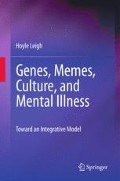Abstract
In the course of evolution, complex organisms arose as effective survival machines for genes. This is not to say that complex organisms replaced simple ones; rather the building of complex structures turned out to be another successful path of survival. Thus humans and bacteria coexist and are both successful, so far. As brains evolved, memory formed by learning, both trial and error and imitative, became transmittable to other brains as memes. Brains and memes, in and outside of the brain, coevolved in humans.
Access this chapter
Tax calculation will be finalised at checkout
Purchases are for personal use only
References
Blackmore, S. J. (1999) The Meme Machine. Oxford University Press, Oxford; New York.
Bruggeman, F. J., van Heeswijk, W. C., Boogerd, F. C., et al. (2000) Macromolecular intelligence in microorganisms. Biol Chem, 381, 965–972.
Carr, L., Iacoboni, M., Dubeau, M. C., et al. (2003) Neural mechanisms of empathy in humans: A relay from neural systems for imitation to limbic areas. Proc Natl Acad Sci USA, 100, 5497–5502.
University of Chicago. (2007) Humans and monkeys share Machiavellian intelligence. http://www.sciencedaily.com/releases/2007/10/071024144314.htm
Crofts, A. R. (2007) Life, information, entropy, and time: Vehicles for semantic inheritance. Complexity, 13, 14–50.
Dennett, D. C. (1995) Darwin’s Dangerous Idea: Evolution and the Meanings of Life. Simon and Schuster, New York.
Eisner, T., Goetz, M., Hill, D., et al. (1997) Firefly “femmes fatales” acquire defensive steroids (lucibufagins) from their firefly prey. Proc Natl Acad Sci USA, 94, 9723–9728.
Feldman, M., Cavalli-Sforza, L. (1976) On the theory of evolution under genetic and cultural transmission with application to the lactose absorption problem. In Mathematic Evolutionary Theory (M. Feldman ed.), pp. 145–173. Princeton University Press, Princeton.
Ferrari, P. F., Gallese, V., Rizzolatti, G., et al. (2003) Mirror neurons responding to the observation of ingestive and communicative mouth actions in the monkey ventral premotor cortex. Eur J Neurosci, 17, 1703–1714.
Ferrari, P. F., Maiolini, C., Addessi, E., et al. (2005a) The observation and hearing of eating actions activates motor programs related to eating in macaque monkeys. Behav Brain Res, 161, 95–101.
Ferrari, P. F., Rozzi, S., Fogassi, L. (2005b) Mirror neurons responding to observation of actions made with tools in monkey ventral premotor cortex. J Cogn Neurosci, 17, 212–226.
Fowler, J. H., Christakis, N. A. (2008) Dynamic spread of happiness in a large social network: Longitudinal analysis over 20 years in the Framingham Heart Study. BMJ, 337, a2338.
Gavrilets, S., Vose, A. (2006) The dynamics of Machiavellian intelligence. Proc Natl Acad Sci USA, 103, 16823–16828.
Gazzola, V., Aziz-Zadeh, L., Keysers, C. (2006) Empathy and the somatotopic auditory mirror system in humans. Curr Biol, 16, 1824–1829.
Goodall, J. (1964) Tool using and aimed throwing in a community of free living chimpanzees. Nature, 201, 1264–1266.
Heyes, C. M., Galef, B. G. J. (eds.) (1996) Social Learning in Animals. Academic Press, San Diego.
Iacoboni, M., Dapretto, M. (2006) The mirror neuron system and the consequences of its dysfunction. Nat Rev Neurosci, 7, 942–951.
Jabbi, M., Swart, M., Keysers, C. (2007) Empathy for positive and negative emotions in the gustatory cortex. Neuroimage, 34, 1744–1753.
Jerison, H. (1973) Evolution of the Brain and Intelligence. Academic Press, New York.
Kandel, E. R. (1979) Psychotherapy and the single synapse. The impact of psychiatric thought on neurobiologic research. N Engl J Med, 301, 1028–1037.
Leland, K., Odling-Smee, J. (2000) The evolution of the meme. In Darwinizing Culture: The Status of Memetics as a Science (R. Aunger ed.), pp. 121–141. Oxford University Press, Oxford.
Lenzi, D., Trentini, C., Pantano, P., et al. (2009) Neural basis of maternal communication and emotional expression processing during infant preverbal stage. Cereb Cortex, 19, 1124–1133.
Molnar-Szakacs, I., Kaplan, J., Greenfield, P. M., et al. (2006) Observing complex action sequences: The role of the fronto-parietal mirror neuron system. Neuroimage, 33, 923–935.
Nesse, R. M., Williams, G. C. (1994) Why We Get Sick. Random House, New York.
Pinker, S. (1994) The Language Instinct. Morrow, New York.
Rizzolatti, G., Craighero, L. (2004) The mirror-neuron system. Annu Rev Neurosci, 27, 169–192.
Schulte-Ruther, M., Markowitsch, H. J., Fink, G. R., et al. (2007) Mirror neuron and theory of mind mechanisms involved in face-to-face interactions: A functional magnetic resonance imaging approach to empathy. J Cogn Neurosci, 19, 1354–1372.
Sugiyama, Y. (1995) Tool-use for catching ants by chimpanzees at Bossou and Monts Nimba, West Africa. Primates, 36, 193–205.
Wood, J., Jackson, K. (2004) Why cephalopods change color. Bermuda Biological Station for Research.
Author information
Authors and Affiliations
Corresponding author
Rights and permissions
Copyright information
© 2010 Springer-Verlag New York
About this chapter
Cite this chapter
Leigh, H. (2010). Learning, Imitation, and Memes. In: Genes, Memes, Culture, and Mental Illness. Springer, New York, NY. https://doi.org/10.1007/978-1-4419-5671-2_8
Download citation
DOI: https://doi.org/10.1007/978-1-4419-5671-2_8
Published:
Publisher Name: Springer, New York, NY
Print ISBN: 978-1-4419-5670-5
Online ISBN: 978-1-4419-5671-2
eBook Packages: MedicineMedicine (R0)

